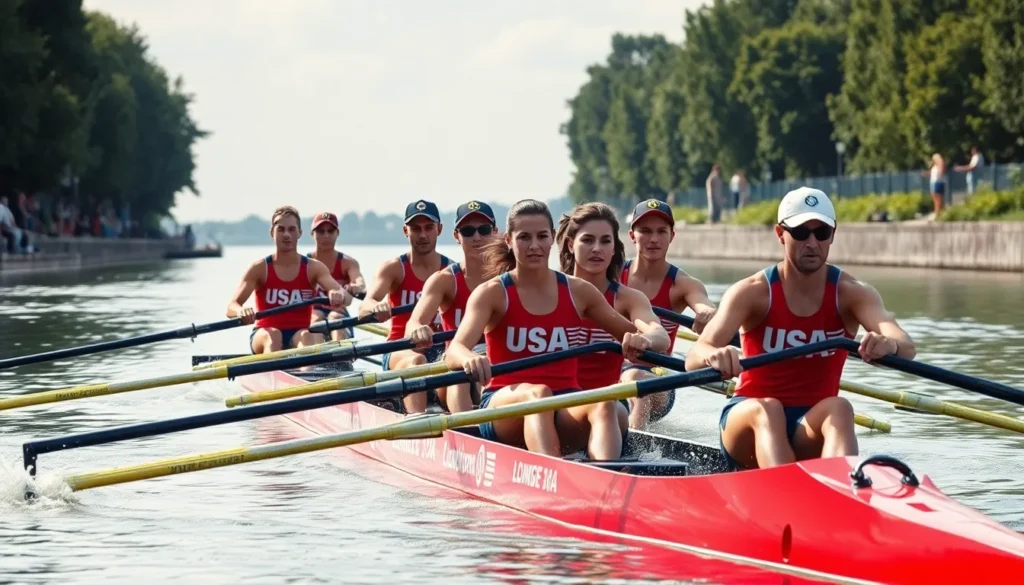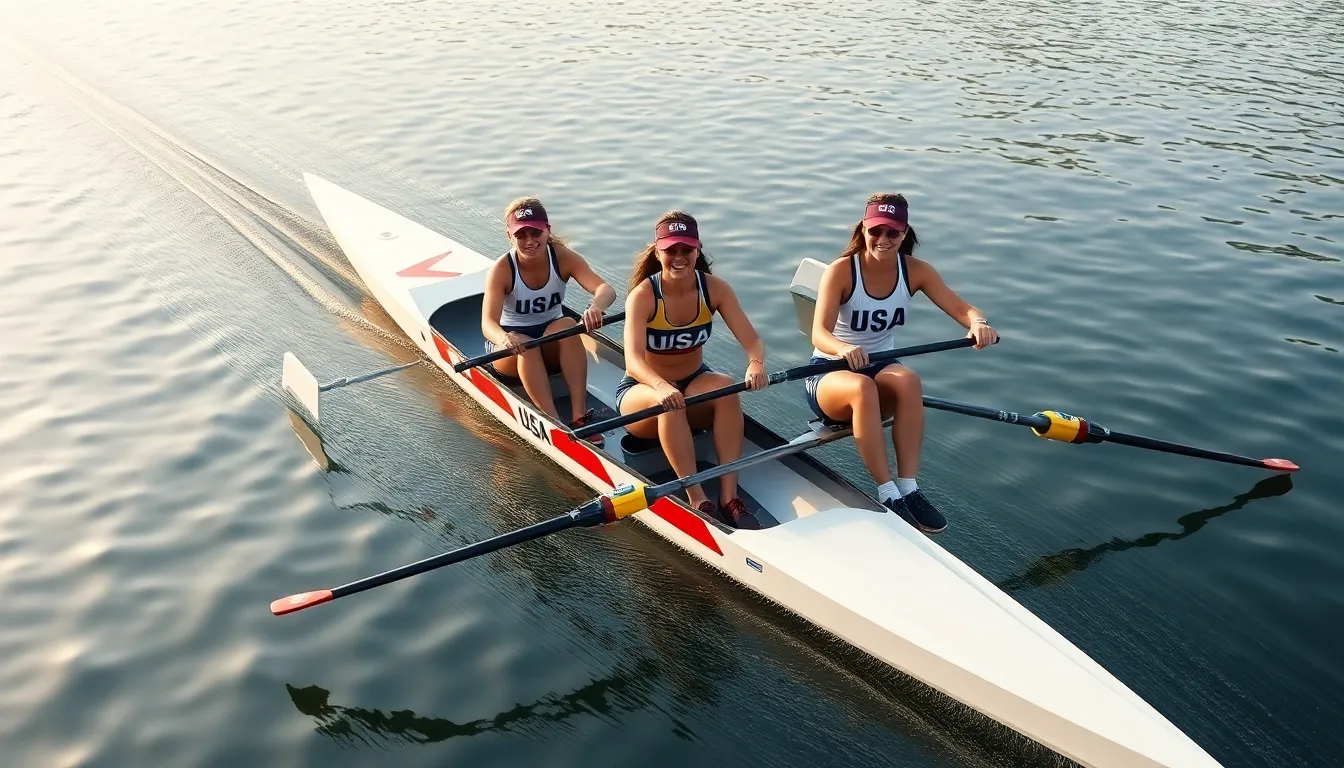Table of Contents
ToggleRowingneden might sound like a secret society of oarsmen, but it’s actually a thrilling sport that combines strength, strategy, and a splash of fun. Picture this: a group of determined athletes gliding across serene waters, muscles straining, and laughter echoing as they race against the clock and each other. It’s not just about rowing; it’s about camaraderie, competition, and the occasional friendly rivalry that keeps everyone on their toes.
Overview of Rowingneden
Rowingneden combines athletic skill with tactical planning, creating a compelling experience for participants. Competitors engage in a variety of formats, including singles, doubles, and quad racing events. Each format emphasizes unique strengths, enhancing the overall challenge for athletes.
Participants train on waterways, focusing on endurance, strength, and synchronization within their teams. The camaraderie developed among crew members fosters not only competitiveness but also lasting friendships. Teams often engage in rigorous training sessions, building both physical capacity and strategic cohesion.
Equipment is crucial in Rowingneden. Boats designed for speed and agility enhance performance, while oars tailored for different rowers contribute to efficiency. Athletes meticulously choose their gear to optimize their racing experience.
Races typically take place in local and regional events, showcasing talent and hard work. Winning a race demands peak performance and dedication from all team members. Spectators often rally, creating an electrifying atmosphere that motivates rowers to excel.
Safety measures in Rowingneden promote responsible sport participation. Life jackets and safety protocols are essential for all athletes, ensuring a secure environment during training and competition. These measures emphasize the importance of well-being in the sport.
As Rowingneden evolves, it continues to attract newcomers. The dynamic combination of athleticism and strategy appeals to many enthusiasts, driving growth in local clubs and events. Engaging in Rowingneden promises challenges and rewards for everyone involved.
Features of Rowingneden
Rowingneden showcases various features that enhance its appeal and functionality. These characteristics contribute to an engaging experience for athletes and spectators alike.
Design Elements
Rowingneden boats emphasize speed and stability. Lightweight materials ensure maximum efficiency while maintaining durability. Sleek designs reduce drag, allowing rowers to glide effortlessly through water. Oars feature ergonomic grips, promoting comfort during prolonged use. Each component integrates meticulously to enhance performance and aesthetics. Additionally, vibrant colors and branding give each team a unique identity, fostering team spirit and cohesion.
Functionality
Functionality plays a crucial role in Rowingneden. Effective steering mechanisms allow for precise navigation, enhancing control during races. The setup supports various formats, from singles to quads, accommodating diverse racing preferences. Built-in safety features, like secure foot restraints, enhance stability and prevent accidents. Ergonomic seating arrangements ensure optimal positioning, promoting endurance and strength throughout races. Collectively, these elements make the sport more accessible, boosting participation and enjoyment.
Benefits of Using Rowingneden
Rowingneden offers numerous benefits for athletes and the environment. Engaging in this sport promotes a healthy lifestyle, fosters teamwork, and actively supports ecological sustainability.
Health Advantages
Rowingneden significantly enhances cardiovascular fitness due to its focus on endurance. Participants engage multiple muscle groups, which increases overall strength. Flexibility improves as rowers develop better range of motion through repetitive movements. Mental health benefits arise from endorphin release during physical activity, reducing stress levels. Social interactions within teams create a sense of community, further contributing to emotional well-being. Regular participation can even lead to weight management, promoting a balanced and active lifestyle.
Environmental Impact
Rowingneden promotes a connection with nature by utilizing waterways rather than motorized sports. This fosters environmental stewardship among athletes, as they develop respect for aquatic ecosystems. The sport encourages awareness of water quality and protection, leading to cleaner environments. Eco-friendly practices during events help minimize ecological footprints. Many rowing clubs actively participate in local conservation efforts, enhancing their community’s natural resources. These initiatives not only benefit the environment but also strengthen the bond among participants, aligning athletic goals with ecological responsibility.
Comparison with Other Rowing Equipment
Rowingneden stands out when compared to traditional rowing equipment such as fixed-seat boats and ergometers. Fixed-seat boats, commonly used in competitive rowing, limit movement and reduce the engagement of core muscles. These boats often prioritize stability over speed, making them suitable for beginners but less adaptable for advanced techniques.
Ergometers, or rowing machines, offer a controlled environment for training. However, the experience differs greatly from on-water rowing. While ergometers simulate the rowing motion effectively, they cannot replicate the wind, water resistance, or teamwork found in Rowingneden. Consequently, the outdoor experience holds unique benefits for physical endurance and social interaction.
Another notable comparison includes the difference between sculling and sweep rowing. In sculling, each rower handles two oars, enhancing mobility and balance. Rowingneden often employs a similar approach, allowing athletes to develop greater agility and coordination. Sweep rowing, however, involves using a single oar per rower, which can create a different dynamic in crew interaction and rhythm.
Safety equipment in Rowingneden also trumps that found in other types of rowing. Advanced life jackets and responsive steering mechanisms ensure thorough protection. Many rowing clubs emphasize safety training, which might not be as stringent in other categories of the sport.
In terms of performance, Rowingneden boats utilize lightweight materials designed for speed and aerodynamics. This construction contrasts significantly with some older types of rowing equipment that may use heavier materials. The focus on optimal design and comfort through ergonomic grips offers notable enhancements for athletes.
When examining the social aspects, Rowingneden fosters camaraderie among participants. While other rowing forms may prioritize individual performance, the community-centric approach distinguishes Rowingneden, enhancing both enjoyment and motivation.
User Experiences and Feedback
Participants often share enthusiasm about Rowingneden, noting its unique blend of physical challenge and mental strategy. Many athletes comment on the camaraderie that develops during training sessions and races. Friendships form through shared experiences on the water, deepening the sense of community.
Feedback frequently highlights the effectiveness of the equipment used in Rowingneden. Rowers express satisfaction with the lightweight boats, which provide both speed and stability. Ergonomic oar designs resonate well with users, enhancing comfort and control. As athletes engage in races, they appreciate the responsiveness of their gear, noting improvements in their performance.
Training routines also generate positive feedback. Athletes value the focus on endurance and strength, which translates into noticeable fitness benefits. Psychological wellness emerges as a key benefit, with rowers enjoying stress relief and social interaction. Comments reveal that these factors contribute to an overall enjoyable experience in the sport.
When it comes to safety, users appreciate robust protocols that ensure a secure environment for training and competition. Life jackets and effective steering mechanisms enhance confidence among participants. The emphasis on safety not only protects athletes but also promotes a culture of well-being within the sport.
Rowingneden’s appeal extends to local clubs promoting environmental stewardship. Many athletes express pride in participating in eco-friendly practices and contribute to conservation efforts. Engagements with community resources enhance their connection to the environment, reinforcing the sport’s positive impact on both athletes and ecosystems.
Overall, experiences in Rowingneden reflect a strong sense of community, effective training methods, and a commitment to safety and environmental responsibility. The feedback underscores the sport’s ability to foster lasting connections while promoting health and enjoyment among participants.
Conclusion
Rowingneden stands out as a sport that not only challenges athletes physically but also nurtures a vibrant community spirit. The blend of teamwork and strategic thinking makes it a unique experience for participants of all skill levels. As athletes navigate the waters together they forge friendships that extend beyond the sport.
The commitment to safety and environmental stewardship further enhances its appeal. With its focus on health benefits and community engagement Rowingneden is more than just a sport; it’s a lifestyle that promotes well-being and ecological responsibility. As it continues to grow it promises to inspire many more to embrace the joys of rowing.








